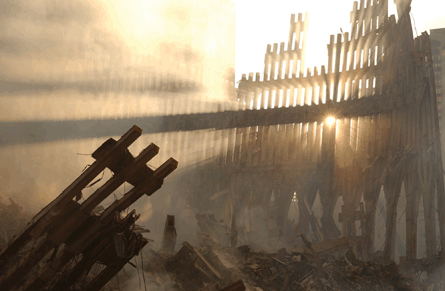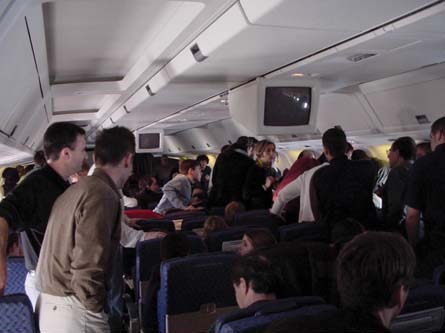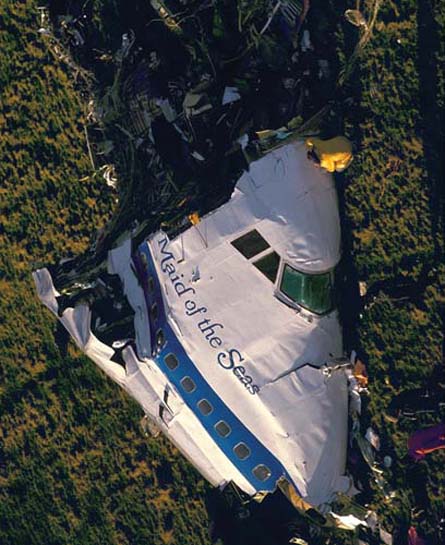The 11 September 2001 terrorist attack on the World Trade Center and Pentagon was unprecedented in scale and ingenuity. But the global commercial airline community was first truly shaken by international terrorism in December 1988, when Pan American flight 103 was blown out of the sky over Lockerbie, Scotland.
When that stricken Boeing 747-100 fell to earth, the result of the explosion that split open the forward fuselage was the loss of all 259 lives on board, and of 11 people in their homes in the village of Lockerbie.
There is a case for saying that, today, the chance of a 9/11-type hijacking has been almost eliminated by physical onboard security measures and radically changed crew in-flight drills, leaving the commercial air transport world still to deal with the Lockerbie-type sabotage threat. If that is so, 9/11 will have been a one-off, and the real threat once more is to individual flights.
 |
|---|
© Rex Features |
The sabotage threat is well established and shows no sign of abating. A year after Pan Am 103, a McDonnell Douglas DC-10 of French carrier UTA crashed in Niger after an onboard explosion, having taken off from N'djamena, Chad, for Paris. All 107 people on board died. Years later, Libya accepted responsibility for both attacks, the presumption by the international community being that they were perpetrated in revenge for American and French military assistance to Chad, which, as a result, successfully resisted Libyan expansionism in Africa.
Before the Pan Am and UTA atrocities, there had been many politically motivated terrorist hijackings, most - but not all - ending with the negotiated release of those on board. They had the feeling, compared with an event like 9/11, of acts of protest rather than of war. Many of them were, in effect, hostage-taking exercises with the aim of negotiating a deal, such as the release of jailed fellow activists.
Immediate reaction to the loss of the veteran Pan Am 747 was bewilderment, because the cause was not known at first. It was less than a week before confirmation came from the UK Air Accidents Investigation Branch that traces of Semtex plastic explosive had been found on the wreckage. Later, it was determined precisely where in the belly hold the improvised explosive device (IED) had been located. The IED had been in checked luggage that, according to police evidence, had originated in Malta and been processed in Frankfurt and Heathrow, but no corresponding passenger was on board Pan Am 103.
Steve Hill is the communications director of Morpho Detection, a Safran group company that acquired the US security firm formerly known as GE Homeland Protection. He says Lockerbie provided the origin of the "concept of operations" that the USA adopted in earnest after 9/11. From Lockerbie onward, the USA thought more in terms of explosives detection than did Europe, which remained more focused on device detection, he says.
 |
|---|
© Rex FeaturesPassengers and crew grapple with would-be shoe bomber Richard Reid |
Although the Pan Am and UTA attacks signalled the arrival of an unprecedented ruthlessness among fundamentalist political or religious groups in their use of civilian air transport operations to gain maximum publicity for their aims, the two attacks were, in almost all respects, utterly unlike the action on 11 September 2001.
The 9/11 attacks on American homeland territory, using American domestic passenger airliners on scheduled flights as guided weapons, introduced aviation to the era of the suicide warrior, which changed everything. Smuggled explosives may have brought down the Pan Am and UTA flights, but explosives had nothing to do with 9/11. The four co-ordinated events on that day all began with aircraft hijackings that were carried out successfully without the use of firearms.
The lessons learned transformed onboard security provision, turned upside down the accepted crew drills in the event of a hijacking threat, and likewise the passenger response in the face of suspicious behaviour by fellow passengers. Onboard cockpit and cabin security were revolutionised, whereas airport security was merely refined and tightened.
SUICIDE FACTOR
In theory, the suicide factor could have been foreseen, but the industry did not want to discuss the possibility openly because the ramifications of accepting it as a real risk were so great. As Morpho's Hill says, security policy and the security industry has been "almost entirely event-driven".
The 9/11 suicide attacks completely invalidated some existing security procedures that, properly exercised, would have prevented the Pan Am and UTA atrocities, but not 9/11. For example, once suicide is in the equation, baggage reconciliation alone would no longer work. Only bag-scanning can be effective, with baggage reconciliation providing an additional layer of security.
But whatever new risks 9/11 revealed, the risk of sabotage to individual aircraft remains today. There had been two apparent failures of security associated with Pan Am 103: baggage checks had failed to spot the device or detect the explosive, and the bag should have been unloaded when the passenger who checked it did not board the aircraft. According to the narrative that emerged from the judicial case heard in a Scottish court, the bag with the IED was loaded at Frankfurt onto a Pan Am 727 scheduled flight to London Heathrow, and checked through to New York on the 747.
The UK Department for Transport, responsible for setting and policing the nation's transport security standards, points out that the most visible airport security procedures that passengers suffer globally today are "not 9/11-related". These are the requirement to remove shoes for X-ray checks, and the restrictions on the carriage of liquids in hand baggage. The former was the result of the attempt by British citizen Richard Reid to conceal explosives in his shoe and detonate them on an Air France flight from Paris to Miami in December 2001 - he was overpowered by cabin crew and passengers in the first manifestation of 9/11-linked changes to cabin behaviour protocols. The latter restriction followed the foiling in 2006 by intelligence-based British police action, of a plot to blow up multiple flights from the UK to the USA using mixed liquid explosive components.
 |
|---|
© Rex Features |
Crew drills on board the world's airliners have radically altered since 9/11. As witnessed on the day itself, the drill then was for crews to accede to an armed hijacker's demands to avoid loss of the aircraft or harm to those on board, on the assumption that negotiation with the hijackers would take place on the ground, conducted by security services.
Hence, the crews of all four hijacked aircraft on the day were faced with forced flightdeck access by the hijackers, who were well-drilled groups of men armed with knives. There had never been an airborne event like this, knowledge of which could have alerted the pilots to the fact that the attackers were intent on taking control and using the aircraft as missiles.
Today, as a direct result of 9/11, cockpit doors are required to be armoured and locked throughout the flight, with video cameras scanning the area outside them for the pilots to be able to judge risk. Today, no physical threats to passengers or cabin crew will cause the pilots to accede to any demands from would-be hijackers, or to emerge from the flightdeck or allow anyone into it. They just fly the aircraft to the nearest diversion and land. Whatever ills befall those in the cabin, the primary job of the pilots becomes one of ensuring that the aircraft cannot be commandeered for any purpose determined by the hijackers. That armoured door and the changed cabin drills are the most significant product of 9/11.
On the day of the 9/11 atrocity itself, passenger behaviour on one of the aircraft changed from passivity to active resistance before it crashed without completing the hijackers' mission.
 |
|---|
© Rex Features |
The fourth of the aircraft to be hijacked, United Flight 93, was scheduled from Newark to San Francisco. After the hijacking action on board, some of the passengers contacted family on mobile telephones and began to get feedback on what appeared to have happened to the other flights. The passengers and crew swarmed to take back control of the aircraft. The hijackers recognised that their attempt to head for a target in Washington DC was not going to work, and the aircraft crashed into a Pennsylvania field. That action has turned out to be a blueprint for today's changed thinking.
In the USA, the Transportation Safety Board, a state agency set up after 9/11 to take over security from the airport- and airline-provided system at the time, decided to reinforce the new onboard security measures by placing armed "air marshals" in civilian clothes on a proportion of flights, and to allow volunteer pilots who agreed to undergo special screening and training, to carry handguns into the flightdeck. The agency confirms there is no record of a TSA air marshal, or an armed pilot, acting in flight to curb an action by someone identified as having terrorist intent, but it is arguable that this benign situation is partly the result of the deterrent effect on would-be terrorists.
Immediately after 9/11, at an international governmental level, allies resolved to boost intelligence-gathering efforts to track terrorist movements and individuals. The direct effect of this on commercial aviation was that passenger identity would be subject to more rigorous scrutiny, and compared electronically with databases containing the details of criminals and terrorist suspects. Airlines were given the responsibility for gathering the passenger information associated with every flight purchase, with the intention that the destination country would be able to vet the manifest before the aircraft took off. This advanced passenger information requirement remains in place.
When it became clear that some of the hijackers had entered the USA to train as pilots at US flight training organisations with the specific purpose of gaining sufficient skill to take over the aircraft after hijacking and navigate them to their targets, the US immigration services were required to vet with additional care the details and backgrounds of all foreign applicants for US-based pilot training. The training of overseas pilot students is a major industry in the USA, and it has been affected by the distinctly unfriendly feel of the checks that candidates must undergo before being cleared to enter the country.
The final line of defence against a hijacked aircraft that looks as if it may be used as a weapon of war is to shoot it down. Before 9/11 that was already true, but since that event, the likelihood that armed fighters will be deployed to destroy an apparently rogue or unidentified aircraft is much greater than it used to be.
The outcome of all the measures that have been put in place since 9/11 is that the chances of a successful repeat of an event like it are small, but the risk of a sabotage attempt is as great as it ever was while the risk of its success is probably reduced.
Direct reactions to 9/11
- Hardened cockpit doors locked throughout flight (universal)
- New flightcrew and cabin crew onboard drills in the event of hijack (universal)
- Armed air marshals (USA)
- Armed pilots (USA)
- Advance passenger details notification to security agencies
- Air traffic control: upgraded military reaction to unidentified or non-communicating aircraft
- Security changes not directly related to 9/11
- Improved landside protection for airport terminals (not universal)
- Universal checked baggage scanning
- Improved cargo screening
- Restrictions on passenger carry-on liquid containers
- Shoe scanning
- Improved levels of screening/vetting for all personnel who work airside
- Improved passenger identification drills
- Proposed or under trial
- Outcomes-based security requirements (UK/Europe consultation on defining the security objective, then giving security providers more flexibility in how they achieve it)
- Whole-body scanners
- Technology companies' proposal under development: integrated single-point walk-through passenger and hand baggage identification and scanning
Source: Flight International
















